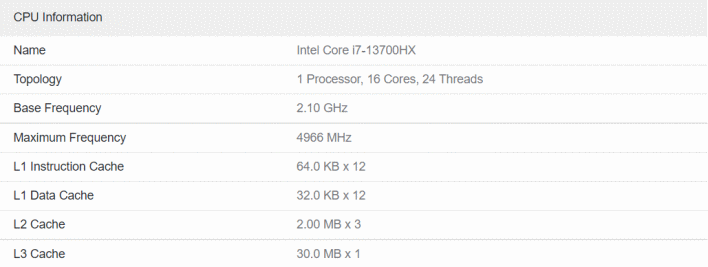Intel Core i7-13700HX Raptor Lake 16-Core Laptop CPU Breaks Cover At 5GHz In Lenovo Leak

See, Raptor Lake is actually more efficient than Alder Lake, which is impressive considering that it's fabricated on the same Intel 7 process. Thanks to architectural changes, like a big bump in L2 cache size, Raptor Lake uses less power to achieve the same performance results as its previous-generation cousins.
Intel hasn't said a peep about laptop Raptor Lake chips, but we've got a fresh leak from Geekbench (via Benchleaks) that confirms a whole bunch of details about the Core i7-13700HX for us. That includes the core count—8 P-cores and 8 E-cores—as well as what may be the maximum boost clock rate of 5 GHz. Both of those specs are identical to the Core i9-12900HX.

The relevant part of the leaked Geekbench result.
Given that information, you might assume that it's just a rebadged 12900HX. After all, most of the lower-end Raptor Lake CPUs are rumored to be rebadged Alder Lake silicon. This is anything but a lower-end processor, though, and Geekbench helpfully puts the kibosh on that issue by listing the cache counts on the CPU. L2 cache is reported at 2MB per core, which marks this chip clearly as new Raptor Lake silicon.
The Geekbench result itself is on the OpenCL compute benchmark, so it's not that interesting; just as previous "HX" processors have been for high-end and gaming laptops, so too is this chip bound for systems with burly discrete GPUs. The particular Lenovo laptop in question comes with a GeForce RTX 3070 Ti laptop card.

